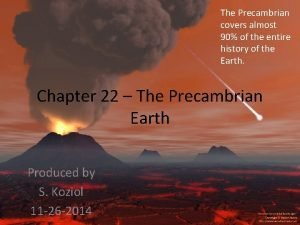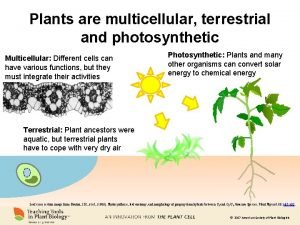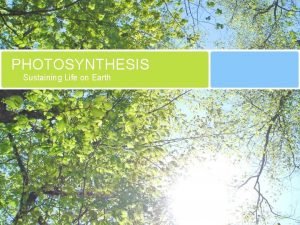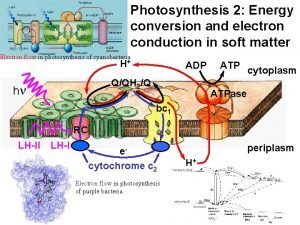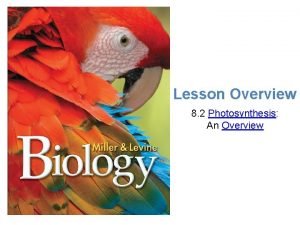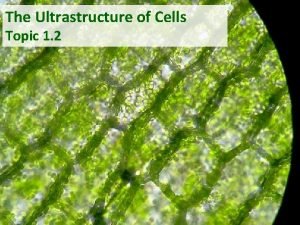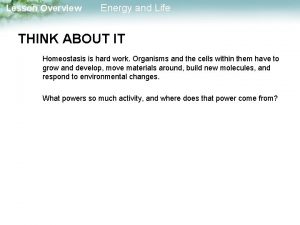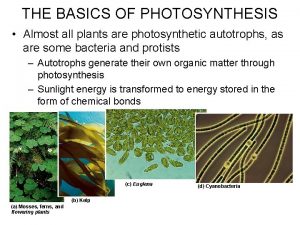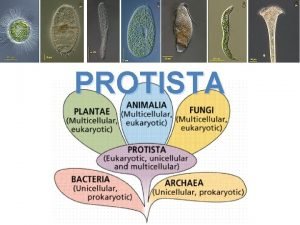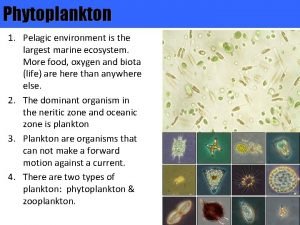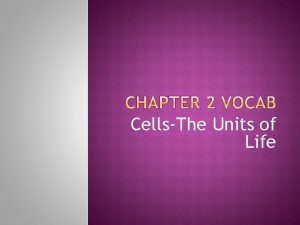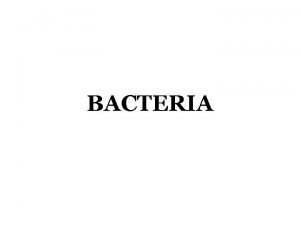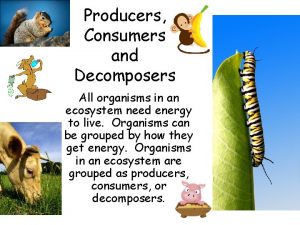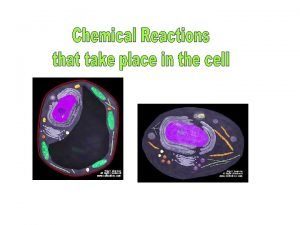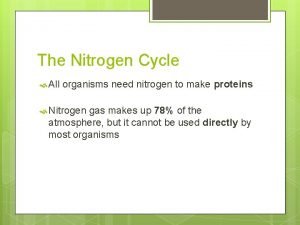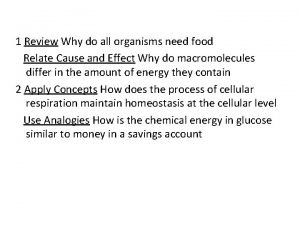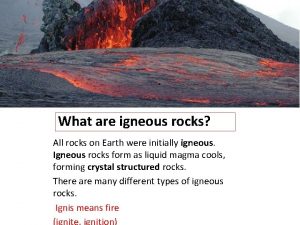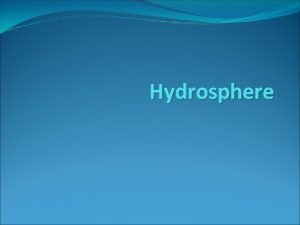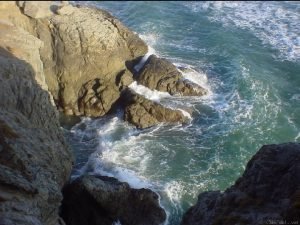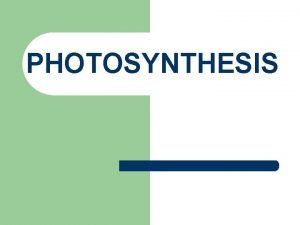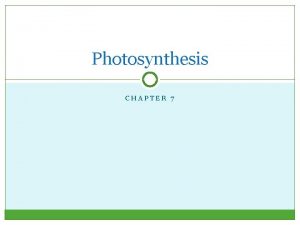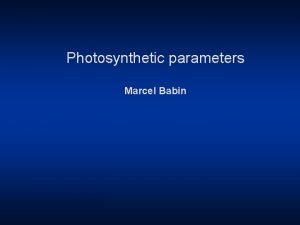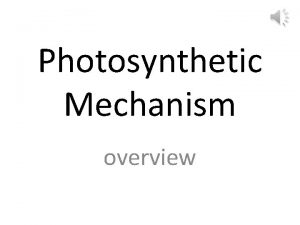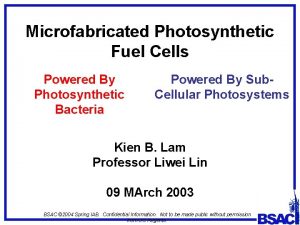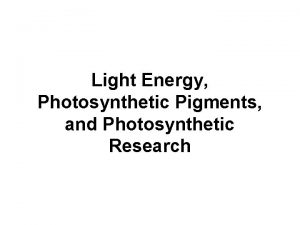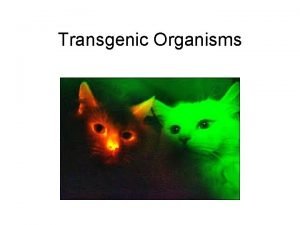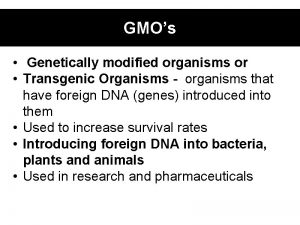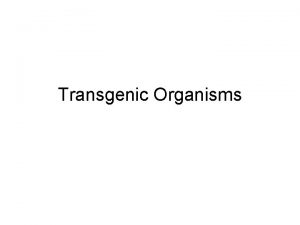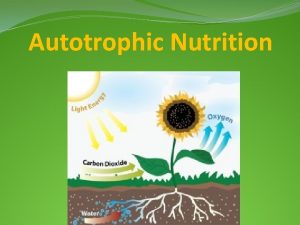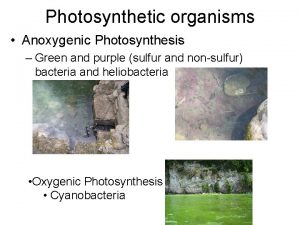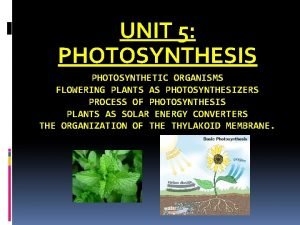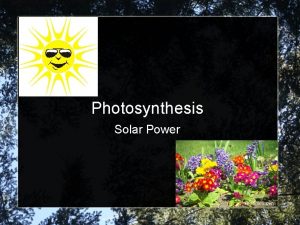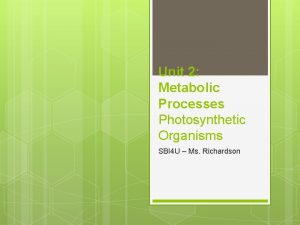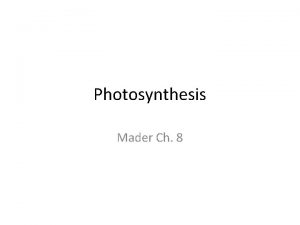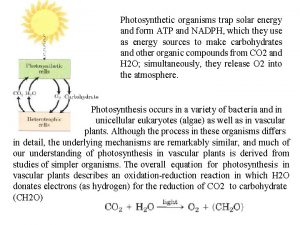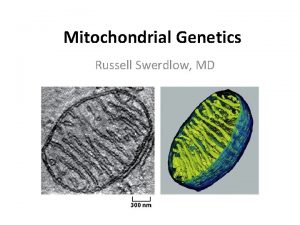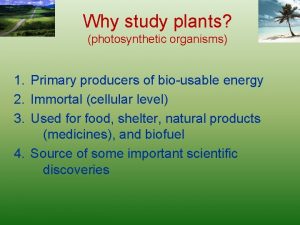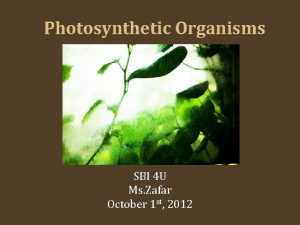7 1 Photosynthetic Organisms All life on Earth































- Slides: 31

7. 1 Photosynthetic Organisms • All life on Earth depends on solar energy • Photosynthetic organisms (algae, plants, and cyanobacteria) transform solar energy into the chemical energy of carbohydrates § Called autotrophs because they produce their own food. • Photosynthesis: § A process that captures solar energy § Transforms solar energy into chemical energy § Energy ends up stored in a carbohydrate • Photosynthesizers produce food energy § Feed themselves as well as heterotrophs 1

Photosynthetic Organisms • Photosynthesis takes place in the green portions of plants § Leaf of flowering plant contains mesophyll tissue § Cells containing chloroplasts are specialized to carry out photosynthesis • The raw materials for photosynthesis are carbon dioxide and water § Roots absorb water that moves up vascular tissue § Carbon dioxide enters a leaf through small openings called stomata and diffuses into chloroplasts in mesophyll cells § In stroma, CO 2 is combined with H 2 O to form C 6 H 12 O 6 (sugar) § Energy supplied by light • Chlorophyll and other pigments absorb solar energy and energize electrons prior to reduction of CO 2 to a carbohydrate 2

Leaves and Photosynthesis Copyright © The Mc. Graw-Hill Companies, Inc. Permission required for reproduction or display. cuticle upper epidermis Leaf cross section mesophyll CO 2 leaf vein outer membrane lower epidermis O 2 stoma inner membrane stroma granum Chloroplast 37, 000 thylakoid space thylakoid membrane Grana independent thylakoid in a granum overlapping thylakoid in a granum © Dr. George Chapman/Visuals Unlimited 3

7. 2 The Process of Photosynthesis • Light Reactions – take place only in the presence of light § § Energy‑capturing reactions Chlorophyll absorbs solar energy This energizes electrons Electrons move down an electron transport chain • Pumps H+ into thylakoids • Used to make ATP out of ADP and NADPH out of NADP • Calvin Cycle Reactions – take place in the stroma § CO 2 is reduced to a carbohydrate § Use ATP and NADPH to produce carbohydrate 4

Overview of Photosynthesis Copyright © The Mc. Graw-Hill Companies, Inc. Permission required for reproduction or display. CO 2 H 2 O solar energy ADP + P NADP+ Light reactions Calvin cycle reactions NADPH ATP stroma thylakoid membrane O 2 CH 2 O 5

7. 3 Plants as Solar Energy Converters • Pigments: § Chemicals that absorb certain wavelengths of light § Wavelengths that are not absorbed are reflected/transmitted • Absorption Spectrum § Pigments found in chlorophyll absorb various portions of visible light § Graph showing relative absorption of the various colors of the rainbow § Chlorophyll is green because it absorbs much of the reds and blues of white light 6

Photosynthetic Pigments and Photosynthesis Copyright © The Mc. Graw-Hill Companies, Inc. Permission required for reproduction or display. Increasing wavelength chlorophyll a chlorophyll b carotenoids Gamma rays X rays UV Micro- Radio Infrared waves visible light 500 600 Wavelengths (nm) a. The electromagnetic spectrum includes visible light. 750 Relative Absorption Increasing energy 380 500 600 750 Wavelengths (nm) b. Absorption spectrum of photosynthetic pigments. 7

Plants as Solar Energy Converters • The light reactions consist of two alternate electron pathways: § Noncyclic pathway § Cyclic pathway • Capture light energy with photosystems § Pigment complex helps collect solar energy like an antenna § Occur in the thylakoid membranes • Both pathways produce ATP • The noncyclic pathway also produces NADPH 8

Plants as Solar Energy Converters • Noncyclic pathway § § Takes place in the thylakoid membrane Uses two photosystems, PS I and PS II captures light energy Causes an electron to be ejected from the reaction center (chlorophyll a) • Electron travels down electron transport chain to PS I • Replaced with an electron from water, which is split to form O 2 and H+ • This causes H+ to accumulate in thylakoid chambers • The H+ gradient is used to produce ATP § PS I captures light energy and ejects an electron • The electron is transferred permanently to a molecule of NADP+ • Causes NADPH production 9

Noncyclic Electron Pathway Copyright © The Mc. Graw-Hill Companies, Inc. Permission required for reproduction or display. CO 2 H 2 O solar energy ADP+ NADP+ Light reactions P Calvin cycle NADPH ATP thylakoid membrane O CH 2 O 10

Noncyclic Electron Pathway Copyright © The Mc. Graw-Hill Companies, Inc. Permission required for reproduction or display. H 2 O CO 2 solar energy ADP+ P NADP+ sun Calvin cycle Light reactions sun NADPH ATP electron acceptor thylakoid membrane electron acceptor energy level O ele ctr on e– e– tra nsp ATP e– CH 2 O ort cha e– e– in ( NADP+ ET C) H+ NADPH e– reaction center pigment complex Photosystem I e– Photosystem II CO 2 H 2 O 2 H+ pigment complex 1 – O 2 2 CH 2 O Calvin cycle reactions 11

Plants as Solar Energy Converters • PS II: § Consists of a pigment complex and electron acceptors § Receives electrons from the splitting of water § Oxygen is released as a gas • Electron transport chain: § Consists of cytochrome complexes and plastoquinone § Carries electrons between PS II and PS I § Also pumps H+ from the stroma into the thylakoid space • PS I: § Has a pigment complex and electron acceptors § Adjacent to the enzyme that reduces NADP+ to NADPH • ATP synthase complex: § Has a channel for H+ flow § H+ flow through the channel drives ATP synthase to join ADP and Pi 12

Organization of a Thylakoid Copyright © The Mc. Graw-Hill Companies, Inc. Permission required for reproduction or display. H 2 O CO 2 solar energy ADP + P NADP + Light reactions Calvin cycle reactions NADPH ATP thylakoid membrane thylakoid space O 2 CH 2 O granum photosystem II electron transport chain H+ stroma photosystem I H+ NADP reductase Pq ee- e- NADP+ NADPH e- e. H+ H 2 O 2 H+ + 1 2 H+ O 2 H+ H+ ATP synthase H+ H+ Thylakoid space H+ ATP H+ H+ chemiosmosis P Stroma + ADP 13

Plants as Solar Energy Converters • The thylakoid space acts as a reservoir for hydrogen ions (H+) • Each time water is oxidized, two H+ remain in the thylakoid space • Transfer of electrons in the electron transport chain yields energy § Used to pump H+ across the thylakoid membrane § Protons move from stroma into the thylakoid space • Flow of H+ back across the thylakoid membrane § Energizes ATP synthase, which § Enzymatically produces ATP from ADP + Pi • This method of producing ATP is called chemiosmosis 14

Tropical Rain Forest Destruction and Climate Change • Tropical rain forests can exist where § Temperatures are above 26º C § Rainfall is heavy (100 -200 cm) and regular • Most plants are woody; many vines and epiphytes; little or no undergrowth • Contribute greatly to CO 2 uptake, slowing global warming § Development has reduced them from 14% to 6% of Earth’s surface § Deforestation accounts for 20 -30% of atmospheric CO 2, but also removes a CO 2 sink § Increasing temperatures also reduce productivity 15

Tropical Rain Forest Destruction and Climate Change Copyright © The Mc. Graw-Hill Companies, Inc. Permission required for reproduction or display. Mean Global Temperature Change (0 c) 5. 5 4. 5 3. 5 maximum likely increase most probable temperature increase for 2 × CO 2 2. 5 1. 5 Minimum likely increase 0. 5 – 0. 5 1860 1940 2020 Year 2060 2100 16

7. 4 Plants as Carbon Dioxide Fixers • A cyclical series of reactions • Utilizes atmospheric carbon dioxide to produce carbohydrates • Known as C 3 photosynthesis • Involves three stages: • Carbon dioxide fixation • Carbon dioxide reduction • Ru. BP regeneration 17

Plants as Carbon Dioxide Fixers • CO 2 is attached to 5 -carbon Ru. BP carboxylase § Results in a 6 -carbon molecule § This splits into two 3 -carbon molecules (3 PG) § Reaction is accelerated by Ru. BP carboxylase (Rubisco) • CO 2 is now “fixed” because it is part of a carbohydrate 18

The Calvin Cycle Reactions Copyright © The Mc. Graw-Hill Companies, Inc. Permission required for reproduction or display. H 2 O CO 2 solar energy ADP + P NADP + Calvin cycle Light reactions NADPH ATP Metabolites of the Calvin Cycle stroma O 2 CH 2 O 3 CO 2 intermediate 3 C 6 3 Ru. BP C 5 3 ADP + 3 6 3 PG C 3 CO 2 fixation CO 2 reduction Calvin cycle P Ru. BP ribulose-1, 5 -bisphosphate 3 PG 3 -phosphoglycerate BPG 1, 3 -bisphoglycerate G 3 P glyceraldehyde-3 -phosphate 6 ATP 6 ADP + 6 P These ATP and NADPH molecules were produced by the light reactions. regeneration of Ru. BP These ATP molecules were produced by the light reactions. 6 BPG C 3 3 ATP 6 NADPH 5 G 3 P C 3 6 NADP+ net gain of one G 3 P Other organic molecules Glucose 19

Plants as Carbon Dioxide Fixers • 3 PG is reduced to BPG • BPG is then reduced to G 3 P • Utilizes NADPH and some ATP produced in the light reactions 20

Reduction of Carbon Dioxide Copyright © The Mc. Graw-Hill Companies, Inc. Permission required for reproduction or display. ATP ADP + 3 PG BPG NADPH P G 3 P NADP+ As 3 PG becomes G 3 P, ATP becomes ADP + P and NADPH becomes NADP+ 21

Plants as Carbon Dioxide Fixers • Regeneration of Ru. BP § Ru. BP used in CO 2 fixation must be replaced § Every three turns of Calvin Cycle: • Five G 3 P (a 3 -carbon molecule) are used • To remake three Ru. BP (a 5 -carbon molecule) • 5 X 3=3 X 5 22

Regeneration of Ru. BP Copyright © The Mc. Graw-Hill Companies, Inc. Permission required for reproduction or display. 5 G 3 P 3 ATP 3 Ru. BP 3 ADP + P As five molecules of G 3 P become three molecules of Ru. BP, three molecules of ATP become three molecules of ADP +P. 23

Plants as Carbon Dioxide Fixers • Importance of the Calvin Cycle: § G 3 P (glyceraldehyde-3 -phosphate) can be converted to many other molecules § The hydrocarbon skeleton of G 3 P can form • Fatty acids and glycerol to make plant oils • Glucose phosphate (simple sugar) • Fructose (which with glucose = sucrose) • Starch and cellulose • Amino acids 24

Fate of G 3 P Copyright © The Mc. Graw-Hill Companies, Inc. Permission required for reproduction or display. G 3 P fatty acid synthesis glucose phosphate amino acid synthesis + fructose phosphate Sucrose (in leaves, fruits, and seeds) Starch (in roots and seeds) Cellulose (in trunks, roots, and branches) 25 © Herman Eisenbeiss/Photo Researchers, Inc.

7. 5 Other Types of Photosynthesis • In hot, dry climates § § Stomata must close to avoid wilting CO 2 decreases and O 2 increases O 2 starts combining with Ru. BP, leading to the production of CO 2 This is called photorespiration • C 4 plants solve the problem of photorespiration § Fix CO 2 to PEP (a C 3 molecule) § The result is oxaloacetate, a C 4 molecule § In hot & dry climates • C 4 plants avoid photorespiration • Net productivity is about 2 -3 times greater than C 3 plants § In cool, moist environments, C 4 plants can’t compete with C 3 plants 26

Chloroplast Distribution in C 4 vs. C 3 Plants Copyright © The Mc. Graw-Hill Companies, Inc. Permission required for reproduction or display. C 3 Plant C 4 Plant mesophyll cells bundle sheath cell vein stoma 27

CO 2 Fixation in C 3 and C 4 Plants Copyright © The Mc. Graw-Hill Companies, Inc. Permission required for reproduction or display. CO 2 Ru. BP Calvin cycle 3 PG G 3 P mesophyll cell a. CO 2 fixation in a C 3 plant, wildflowers CO 2 mesophyll C 4 cell bundle sheath cell CO 2 Calvin cycle G 3 P b. CO 2 fixation in a C 4 plant, corn, Zea mays a: © Brand X Pictures/Punch. Stock RF; b: Courtesy USDA/Doug Wilson, photographer 28

Other Types of Photosynthesis • CAM Photosynthesis § Crassulacean-Acid Metabolism § CAM plants partition carbon fixation by time • During the night – CAM plants fix CO 2 – Form C 4 molecules, which are – Stored in large vacuoles • During daylight – NADPH and ATP are available – Stomata are closed for water conservation – C 4 molecules release CO 2 to Calvin cycle 29

CO 2 Fixation in a CAM Plant Copyright © The Mc. Graw-Hill Companies, Inc. Permission required for reproduction or display. night CO 2 C 4 day CO 2 Calvin cycle G 3 P CO 2 fixation in a CAM plant, pineapple, Ananas comosus © S. Alden/Photo. Link/Getty Images. 30

Other Types of Photosynthesis • Each method of photosynthesis has advantages and disadvantages § Depends on the climate • C 4 plants most adapted to: § High light intensities § High temperatures § Limited rainfall • C 3 plants better adapted to § Cold (below 25°C) § High moisture • CAM plants are better adapted to extreme aridity § CAM occurs in 23 families of flowering plants § Also found among nonflowering plants 31
 Which kingdoms have photosynthetic organisms? *
Which kingdoms have photosynthetic organisms? * Tiny, threadlike photosynthetic organisms
Tiny, threadlike photosynthetic organisms Member of the same species
Member of the same species Unicellular and multicellular living things
Unicellular and multicellular living things Photosynthetic multicellular and terrestrial
Photosynthetic multicellular and terrestrial What is a photosynthetic organism
What is a photosynthetic organism Euglena amoeba paramecium volvox
Euglena amoeba paramecium volvox Photosynthetic apparatus
Photosynthetic apparatus Chloroplast contain saclike photosynthetic membranes called
Chloroplast contain saclike photosynthetic membranes called Cell
Cell Ground tissue
Ground tissue Photosynthetic cells
Photosynthetic cells Photosynthetic autotroph
Photosynthetic autotroph What kingdom is photosynthetic aquatic and unicellular
What kingdom is photosynthetic aquatic and unicellular Pelagic plankton
Pelagic plankton What unit of size are the smallest organisms found on earth
What unit of size are the smallest organisms found on earth What organisms are most numerous on earth?
What organisms are most numerous on earth? Name all the rays
Name all the rays Are producers decomposers
Are producers decomposers Where do all organisms get their energy
Where do all organisms get their energy Why do organisms need nitrogen?
Why do organisms need nitrogen? Why do organisms need food
Why do organisms need food Smallest living unit of life
Smallest living unit of life Igneous rock formation
Igneous rock formation Great is thy name oh lord
Great is thy name oh lord All authority in heaven and earth
All authority in heaven and earth Who am i that the lord of all the earth
Who am i that the lord of all the earth The hydrosphere includes the
The hydrosphere includes the All the earth will sing your praises
All the earth will sing your praises Lord of all creation of water earth and sky
Lord of all creation of water earth and sky Not because of who i am
Not because of who i am My jesus my comfort
My jesus my comfort

